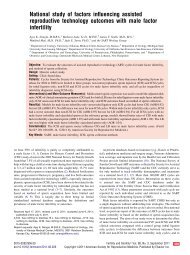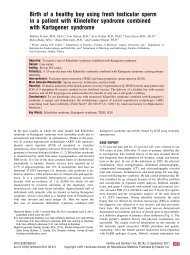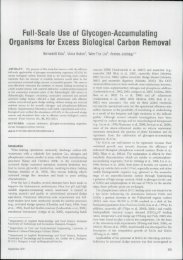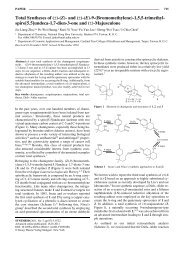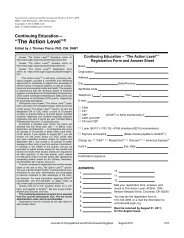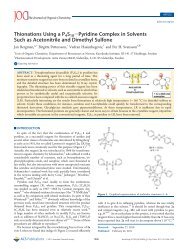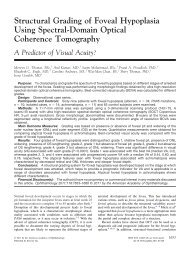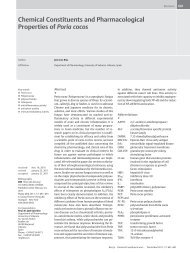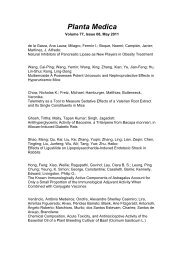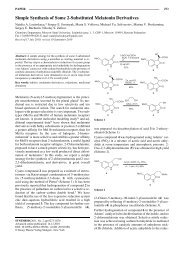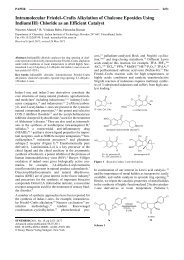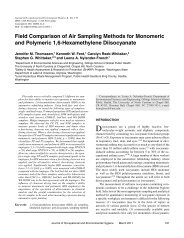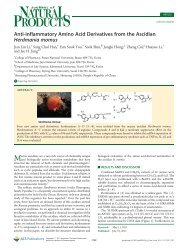Catalyst-Free One-Pot Reductive Alkylation of Primary and ...
Catalyst-Free One-Pot Reductive Alkylation of Primary and ...
Catalyst-Free One-Pot Reductive Alkylation of Primary and ...
You also want an ePaper? Increase the reach of your titles
YUMPU automatically turns print PDFs into web optimized ePapers that Google loves.
490<br />
PAPER<br />
<strong>Catalyst</strong>-<strong>Free</strong> <strong>One</strong>-<strong>Pot</strong> <strong>Reductive</strong> <strong>Alkylation</strong> <strong>of</strong> <strong>Primary</strong> <strong>and</strong> Secondary<br />
Amines <strong>and</strong> N,N-Dimethylation <strong>of</strong> Amino Acids Using Sodium Borohydride in<br />
2,2,2-Trifluoroethanol<br />
<strong>One</strong>-<strong>Pot</strong> Mahmood <strong>Reductive</strong> <strong>Alkylation</strong> <strong>of</strong> <strong>Primary</strong> <strong>and</strong> Secondary Amines Tajbakhsh,* a Rahman Hosseinzadeh, a Heshmatollah Alinezhad, a Somayeh Ghahari, a Akbar Heydari, b<br />
Samad Khaksarc a Department <strong>of</strong> Chemistry, University <strong>of</strong> Maz<strong>and</strong>aran, P. O. Box 453, Babolsar 47415, Iran<br />
Fax +98(112)5342350; E-mail: Tajbaksh@umz.ac.ir<br />
b Chemistry Department, Tarbiat Modares University, P. O. Box 14115-175, Tehran 18716, Iran<br />
c Chemistry Department, Islamic Azad University, Ayatollah Amoli Branch, P.O. Box 678, Amol, Iran<br />
Received 9 November 2010; revised 25 November 2010<br />
Abstract: A simple <strong>and</strong> convenient procedure for the reductive<br />
alkylation <strong>of</strong> primary <strong>and</strong> secondary amines <strong>and</strong> N,N-dimethylation<br />
<strong>of</strong> amino acids is described using sodium borohydride as a reducing<br />
agent in 2,2,2- trifluoroethanol without use <strong>of</strong> a catalyst or any other<br />
additive. The solvent can be readily recovered from reaction products<br />
in excellent purity for direct reuse.<br />
Key words: reductive amination, 2,2,2-trifluoroethanol, sodium<br />
borohydride, reductive methylation<br />
Secondary or tertiary amino group is <strong>of</strong>ten embedded as a<br />
structural motif in various biologically active compounds,<br />
1,2 which are important intermediates in the synthesis<br />
<strong>of</strong> pharmaceutically active substances, dyes, <strong>and</strong><br />
fine chemicals. 3 The direct reductive amination <strong>of</strong> aldehydes<br />
<strong>and</strong> ketones with metal hydride reagents is one <strong>of</strong><br />
the most useful methods for the synthesis <strong>of</strong> secondary<br />
<strong>and</strong> tertiary amines. 4 Several reagents which effect reductive<br />
amination have been developed, including: catalytic<br />
hydrogenation, 4b Et 3SiH–CF 3CO 2H, 5 Zn/AcOH, 6<br />
Bu 2SnClH/HMPA, 7 NaBH 3CN, 8a NaBH(OAc) 3, 8b pyridine·BH<br />
3, 8c ZnCl 2/ZnBH 4, 8d silica gel/Zn(BH 4) 2, 8e<br />
Ti(Oi-Pr) 4/NaBH 4, 8f NiCl 2/NaBH 4, 8g NaBH 4/ZrCl 4, 8h<br />
NaBH 4/H 2SO 4, 8i NaBH 4/H 3PW 12O 40, 8j NaBH 4/guanidine<br />
hydrochloride, 8k NaBH 4/wet clay-microwave, 8l borohydride<br />
exchange resin, 8m N-methylpyrrolidine/zinc borohydride,<br />
9 InCl 3/Et 3SiH, 10 ZnClO 4/InCl 3/Et 3SiH, 11 <strong>and</strong> zirconium<br />
borohydride/piperazine complex. 12 However,<br />
some <strong>of</strong> these preparations require relatively expensive<br />
reagents, harsh reaction conditions, <strong>and</strong> sometimes tedious<br />
workup; produce heavy metals as toxic waste; generate<br />
toxic by-products; have no chemoselectivity; <strong>and</strong><br />
suffer from lack <strong>of</strong> solubility <strong>of</strong> reagents in most common<br />
organic solvents. Furthermore, sometimes direct reductive<br />
amination is performed under anhydrous conditions<br />
in order to avoid decomposition <strong>of</strong> the reducing agents or<br />
catalysts, <strong>and</strong> to enhance generation <strong>of</strong> the intermediate<br />
imines or iminium ions. As a result, the selection <strong>of</strong> the reagent<br />
is crucial. If one could perform the direct reductive<br />
SYNTHESIS 2011, No. 3, pp 0490–0496xx.xx.2011<br />
Advanced online publication: 28.12.2010<br />
DOI: 10.1055/s-0030-1258384; Art ID: Z26810SS<br />
© Georg Thieme Verlag Stuttgart · New York<br />
amination <strong>of</strong> carbonyl compounds in air <strong>and</strong> in the presence<br />
<strong>of</strong> moisture, it should be <strong>of</strong> considerable interest.<br />
Thus, it is challenging to develop such an effective catalyst<br />
or reagent.<br />
Environmental concern associated with chemical synthesis<br />
has posed stringent <strong>and</strong> compelling dem<strong>and</strong>s for greener<br />
processes. 13 Fluorinated solvents have attracted an<br />
increasing interest in the context <strong>of</strong> green synthesis during<br />
recent years. Fluorinated solvents were initially introduced<br />
as an alternative green reaction media because <strong>of</strong><br />
their unique chemical <strong>and</strong> physical properties <strong>of</strong> nonvolatility,<br />
nonflammability, polarity, high ionizing power, <strong>and</strong><br />
low nucleophilicity. Therefore, today they have marched<br />
far beyond this border, showing their significant role in<br />
controlling the reaction as powerful reaction media. 14 Reactions<br />
in fluorinated solvents are generally selective <strong>and</strong><br />
without effluents, allowing thus a facile isolation <strong>of</strong> the<br />
product <strong>and</strong> a recovery <strong>of</strong> the solvent by distillation. Due<br />
to the current challenges for developing environmentally<br />
benign synthetic processes <strong>and</strong> in continuation <strong>of</strong> our interest<br />
in the application <strong>of</strong> fluorinated solvents for various<br />
organic transformations, 15 we report a simple <strong>and</strong> convenient<br />
procedure for the high yielding direct reductive<br />
amination <strong>of</strong> aldehydes <strong>and</strong> ketones with NaBH4 in 2,2,2trifluoroethanol<br />
(TFE) (Scheme 1).<br />
R 1<br />
O<br />
R 2<br />
+<br />
H<br />
N<br />
R3 R4 NaBH4<br />
TFE<br />
N<br />
R1 R3 R<br />
Scheme 1 <strong>Reductive</strong> amination <strong>of</strong> aldehydes <strong>and</strong> ketones<br />
1 , R2 , R3 , R4 aryl, alkyl<br />
H, =<br />
To show the effectiveness <strong>of</strong> TFE in this reaction, aniline<br />
was treated with 4-chlorobenzaldehyde in the presence <strong>of</strong><br />
NaBH4 at 35–40 °C in different organic solvents <strong>and</strong> the<br />
results are presented in Table 1.<br />
It is clear from Table 1 that TFE exert beneficial rate acceleration<br />
on the amination <strong>of</strong> 4-chlorobenzaldehyde<br />
(Table 1, entry 3), whereas reaction in ethanol <strong>and</strong> methanol<br />
proceeds quite slowly (entries 1 <strong>and</strong> 2). Reaction in<br />
R 2<br />
R 4
PAPER <strong>One</strong>-<strong>Pot</strong> <strong>Reductive</strong> <strong>Alkylation</strong> <strong>of</strong> <strong>Primary</strong> <strong>and</strong> Secondary Amines 491<br />
Table 1 <strong>Reductive</strong> Amination <strong>of</strong> 4-Chlorobenzaldehyde with<br />
Aniline in Different Solvents<br />
Entry Solvent Time (h) Yield (%) a<br />
1 EtOH 10 80<br />
2 MeOH 10 84<br />
3 TFE 10 min 93<br />
4 H 2O 12 33<br />
5 MeCN 12 48<br />
6 THF 12 45<br />
a Yields refer to the isolated product, N-(4-chlorophenyl)benzylamine.<br />
other solvents even at longer time did not give acceptable<br />
yield <strong>of</strong> the product (entries 4–6).<br />
Then, the reductive amination <strong>of</strong> a wide variety <strong>of</strong> aliphatic,<br />
aromatic <strong>and</strong> heterocyclic carbonyl compounds (1<br />
mmol) with primary <strong>and</strong> secondary amines (1 mmol) using<br />
NaBH4 (1.2 mmol) in TFE (2 mL) was examined at<br />
35–40 °C for 1–35 minutes. The pure desired products<br />
were obtained in excellent yields (88–96%), simply by filtration<br />
<strong>of</strong> the reaction mixture <strong>and</strong> distilling <strong>of</strong>f the solvent<br />
as summarized in Table 2. It is worth to mention that<br />
under our st<strong>and</strong>ard conditions, direct reductive amination<br />
<strong>of</strong> 4-cyano- or 2-nitrobenzaldehydes with aniline proceeded<br />
smoothly to give the desired alkylated anilines<br />
(Table 2, entries 2 <strong>and</strong> 6). With these results in h<strong>and</strong>, the<br />
regioselective one-pot reductive amination <strong>of</strong> trans-cinnamaldehyde<br />
with aniline similarly afforded the expected<br />
Table 2 <strong>Reductive</strong> Amination <strong>of</strong> Carbonyl Compounds Using NaBH 4 in TFE a<br />
amine in high isolated yield (Table 2, entry 14). Comparably,<br />
ketones were efficiently aminated with the aromatic<br />
<strong>and</strong> aliphatic amines (Table 2, entries 20 <strong>and</strong> 27–32).<br />
In addition, N,N-dimethylamines are important intermediates<br />
in the production <strong>of</strong> pharmaceuticals, agrochemicals,<br />
<strong>and</strong> fragrance compounds. 1,2 Several reagents for N-methylation<br />
<strong>of</strong> the amino function to give tertiary amines have<br />
been developed, including: sodium or potassium hydridotetracarbonyl<br />
ferrate in ethanol or tetrahydr<strong>of</strong>uran, 33 sodium<br />
borohydride in methanol, 34 sodium<br />
cyanotrihydridoborate in acetonitrile, 35 ZnCl2/NaBH4, 36<br />
NaBH4 in THF, 37 MeS·BH3, 38 zinc-modified cyanoborohydride,<br />
4e Zr(BH4) 2Cl2(dabco) 2, ZrBDC, 21 ZBNMPP, 39<br />
Ti(Oi-Pr) 4/NaBH4, 40 carboxylic acids/NaBH4, 41 <strong>and</strong><br />
NaBH3CN/MeCN. 8a Besides, N,N-dimethylated a-amino<br />
acids are very important compounds in biological<br />
chemistry42 <strong>and</strong> several reagents such as formaldehyde/<br />
palladized charcoal/H2, 43–46 formaldehyde/sodium cyanoborohydride,<br />
47 formaldehyde/zinc, 48 <strong>and</strong> formaldehyde/Pd(OH)<br />
2/C49 have been reported for their synthesis<br />
in the literature. Good yields <strong>and</strong> selectivities for the preparation<br />
<strong>of</strong> N,N-dimethylamino acids have been achieved<br />
only by indirect multistep procedures. 50 Although most <strong>of</strong><br />
these procedures are effective, some <strong>of</strong> them have certain<br />
drawbacks, for example: tedious workup, 33 formation <strong>of</strong><br />
aminodiethers34 or cyanide ion, 35 partial methylation, 35<br />
long reaction times, 36 acidic condition, 37 <strong>and</strong> use <strong>of</strong> transition-metal<br />
catalyst or hydrogen atmosphere. 43–46 Here,<br />
we report an efficient method for N-methylation <strong>of</strong><br />
amines <strong>and</strong> amino acids to tertiary products using<br />
paraformaldehyde <strong>and</strong> NaBH4 in TFE (Scheme 2).<br />
Entry Aldehyde/ketone Amine Product b Time (min) Yield (%) c<br />
1 PhCHO PhNH 2 PhCH 2NHPh 6 95 16<br />
2 4-NCC 6H 4CHO PhNH 2 4-NCC 6H 4CH 2NHPh 7 94 17<br />
3 4-ClC 6H 4CHO PhNH 2 4-ClC 6H 4CH 2NHPh 10 93 12<br />
4 2-ClC 6H 4CHO PhNH 2 2-ClC 6H 4CH 2NHPh 10 94 18<br />
5 3-ClC 6H 4CHO PhNH 2 3-ClC 6H 4CH 2NHPh 10 93 18<br />
6 2-O 2NC 6H 4CHO PhNH 2 2-O 2NC 6H 4CH 2NHPh 10 90 8k<br />
7 4-MeC 6H 4CHO PhNH 2 4-MeC 6H 4CH 2NHPh 15 92 19<br />
8 4-MeOC 6H 4CHO PhNH 2 4-MeOC 6H 4CH 2NHPh 35 94 16<br />
9 PhCHO 4-ClC 6H 4NH 2 4-ClC 6H 4NHCH 2Ph 5 93 20<br />
10 PhCHO 4-O 2NC 6H 4NH 2 4-O 2NC 6H 4NHCH 2Ph 10 92 8b<br />
11 PhCHO 4-MeOC 6H 4NH 2 4-MeOC 6H 4NHCH 2Ph 5 94 20<br />
12 PhCHO 4-EtOC 6H 4NH 2 4-EtOC 6H 4NHCH 2Ph 10 96 21<br />
13 PhCHO 4-MeC 6H 4NH 2 4-MeC 6H 4NHCH 2Ph 4 94 22<br />
14 PhCH=CHCHO PhNH 2 PhCH=CHCH 2NHPh 20 90 23<br />
15 PhCHO PhCH 2NH 2 PhCH 2NHCH 2Ph 16 93 20<br />
Synthesis 2011, No. 3, 490–496 © Thieme Stuttgart · New York
492 M. Tajbakhsh et al. PAPER<br />
Table 2 <strong>Reductive</strong> Amination <strong>of</strong> Carbonyl Compounds Using NaBH 4 in TFE a (continued)<br />
Entry Aldehyde/ketone Amine Product b Time (min) Yield (%) c<br />
16 PhCHO PhNHMe PhCH 2N(Me)Ph 30 94 24<br />
17 PhNH2 6 8816 H<br />
O<br />
18 PhNH2 8 9016 O<br />
H<br />
19 PhCHO 5 91 25<br />
20 PhCOMe PhNH2 PhCH(Me)NHPh 27 9023 NH2<br />
N N N<br />
H<br />
21 PhCHO morpholine 4-benzylmorpholine 2 92 9<br />
22 PhCHO piperidine 1-benzylpiperidine 4 95 26<br />
23 PhCHO pyrrolidine 1-benzylpyrrolidine 8 94 27<br />
24 PhCHO CH 2=CHCH 2NH 2 PhCH 2NHCH 2CH=CH 2 1 92 27<br />
25 PhCHO i-PrNH 2 PhCH 2NHi-Pr 2 90 28<br />
26 PhCHO t-BuNH 2 PhCH 2NHt-Bu 2 93 8b<br />
27 cyclohexanone PhNH 2 cyclohexylphenylamine 22 92 16<br />
28 cyclohexanone morpholine 4-cyclohexylmorpholine 5 91 16<br />
29 cyclohexanone piperidine 1-cyclohexylpiperidine 1 93 29<br />
30 cyclohexanone pyrrolidine 1-cyclohexylpyrrolidine 4 94 30<br />
31 cyclohexanone CH 2=CHCH 2NH 2 allylcyclohexylamine 1 92 28<br />
32 Me(CH 2) 4COMe PhNH 2 Me(CH 2) 4CH(Me)NHPh 2 92 31<br />
33 MeCH 2CH 2CHO PhNH 2 MeCH 2CH 2CH 2NHPh 5 93 19<br />
34 MeCH 2CH 2CHO pyrrolidine 1-butylpyrrolidine 1 90 32<br />
a All reactions were carried out at 35–40 °C <strong>and</strong> the molar ratio <strong>of</strong> NaBH4/carbonyl compound/amine was 1.2:1:1.<br />
b All products were characterized by spectroscopic data (NMR, IR), physical properties, <strong>and</strong> by comparison with authentic samples.<br />
c Yields refer to pure isolated products.<br />
H<br />
R 1 N R 2<br />
+<br />
S<br />
(HCHO)n<br />
R<br />
Scheme 2 <strong>Reductive</strong> methylation <strong>of</strong> amines<br />
1 , R2 alkyl, aryl<br />
H, =<br />
O<br />
NaBH 4<br />
TFE, reflux<br />
Similar to reductive amination, the effect <strong>of</strong> solvent was<br />
examined <strong>and</strong> the results in Table 3 for the reaction <strong>of</strong> ptoluidine<br />
with paraformaldehyde <strong>and</strong> NaBH 4 in 1:5:2 molar<br />
ratio showed beneficial rate acceleration in the formation<br />
<strong>of</strong> N,N-dimethyl-p-toluidine in TFE (Table 3, entry<br />
3). When phenylglycine, as representative <strong>of</strong> an amino<br />
acid, reacted with paraformaldehyde <strong>and</strong> NaBH 4 in a 1:9:4<br />
molar ratio in TFE for 40 hours, a high yield (89%) <strong>of</strong><br />
N,N-dimethylphenylglycine was obtained, whereas this<br />
Synthesis 2011, No. 3, 490–496 © Thieme Stuttgart · New York<br />
Me<br />
R 1 N R 2<br />
O<br />
S<br />
H<br />
Ph N<br />
H<br />
Ph N<br />
Ph<br />
reaction in other solvents listed in Table 3 did not afford<br />
any reasonable yield <strong>of</strong> the product (
PAPER <strong>One</strong>-<strong>Pot</strong> <strong>Reductive</strong> <strong>Alkylation</strong> <strong>of</strong> <strong>Primary</strong> <strong>and</strong> Secondary Amines 493<br />
Table 4 <strong>Reductive</strong> Methylation <strong>of</strong> Amines <strong>and</strong> Amino Acids with (HCHO) n/NaBH 4 in TFE a<br />
Entry Amine or amino acid Product b Time (h) Yield (%) c<br />
1 PhNHMe PhNMe 2 1.10 93 21<br />
2 4-MeOC 6H 4NH 2 4-MeOC 6H 4NMe 2 1.30 93 36<br />
3 4-MeC 6H 4NH 2 4-MeC 6H 4NMe 2 2 94 28<br />
4 4-EtOC 6H 4NH 2 4-EtOC 6H 4NMe 2 1.15 95 21<br />
5 4-BrC 6H 4NH 2 4-BrC 6H 4NMe 2 4.30 94 40<br />
6 4-ClC 6H 4NH 2 4-ClC 6H 4NMe 2 6.30 90 51<br />
7 4-O 2NC 6H 4NH 2 4-O 2NC 6H 4NMe 2 7 92 51<br />
8 morpholine 4-methylmorpholine 3.20 87 28<br />
9 piperidine 1-methylpiperidine 4.15 85 29<br />
10 pyrrolidine 1-methylpyrrolidine 3.50 88 52<br />
11 PhCH 2NH 2 PhCH 2NMe 2 3.10 90 8h<br />
12 cyclohexylamine N,N-dimethylcyclohexylamine 2.40 91 53<br />
13 4-H 2NC 6H 4NH 2 4-Me 2NC 6H 4NMe 2 16 93 42<br />
14 a-phenylglycine N,N-dimethyl-a-phenylglycine 40 89<br />
15 alanine N,N-dimethylalanine 48 90<br />
16 glycine N,N-dimethylglycine 24 91<br />
17 L-phenylalanine<br />
{[a] D 20 –34}<br />
To test the generality <strong>of</strong> this procedure, various amines<br />
were subjected to reductive methylation <strong>and</strong> the results<br />
are presented in Table 4. As shown in Table 4, reductive<br />
methylation <strong>of</strong> aromatic amines with different substituents<br />
gives excellent yields <strong>of</strong> the corresponding tertiary<br />
amines (Table 4, entries 1–4). We did not encounter any<br />
problem in the methylation <strong>of</strong> low basicity amines such as<br />
4-nitro- <strong>and</strong> 4-chloroanilines, but just for completion <strong>of</strong><br />
the reaction, higher amounts <strong>of</strong> reagents were required<br />
(Table 4, entries 5–7). <strong>Reductive</strong> methylation <strong>of</strong> aliphatic<br />
amines such as piperidine, cyclohexylamine, pyrrolidine,<br />
morpholine, <strong>and</strong> benzylamine under reaction conditions<br />
gave good to excellent yields <strong>of</strong> the expected tertiary<br />
amines (Table 4, entries 8–12). Similarly, 1,4-phenylenediamine<br />
was reacted to give N,N,N¢,N¢-tetramethyl-1,4phenylenediamine<br />
in excellent yield (Table 4, entry 13).<br />
This procedure was then applied to some amino acids. As<br />
shown in Table 4, the amino acids were N,N-dimethylated<br />
under reaction conditions (Table 4, entries 14–19). It is interesting<br />
to mention that during the course <strong>of</strong> this reaction<br />
the stereogenic center <strong>of</strong> starting amino acid is not<br />
N,N-dimethyl-L-phenylalanine<br />
{[a] D 20 +76}<br />
24 89<br />
18 leucine N,N-dimethylleucine 48 88<br />
19 proline N-methylproline 72 87<br />
a All reactions were carried out at reflux temperature with a molar ratio <strong>of</strong> amine/paraformaldehyde/NaBH4 = 1:5:2 for entries 1–4 <strong>and</strong> 8–13;<br />
1:8:4 for entries 5–7; <strong>and</strong> 1:9:4 for entries 14–19.<br />
b All products were characterized by spectroscopic data (NMR, IR), physical properties, <strong>and</strong> by comparison with authentic samples.<br />
c Yields refer to pure isolated products.<br />
changed as determined by measurement <strong>of</strong> optical rotation<br />
<strong>of</strong> the corresponding product (Table 4, entry 17). An<br />
interesting feature <strong>of</strong> this method is that TFE can be easily<br />
recovered by distillation <strong>and</strong> reused for several times.<br />
In summary, we have introduced a simple procedure for<br />
the reductive amination <strong>of</strong> aldehydes <strong>and</strong> ketones with<br />
NaBH4 in TFE without using any catalyst or additives. In<br />
addition, N-methylation <strong>of</strong> amines <strong>and</strong> amino acids to<br />
their corresponding tertiary products were also achieved<br />
using paraformaldehyde <strong>and</strong> NaBH4 in TFE. Simple<br />
workup procedure, excellent yields, neutral reaction conditions,<br />
recovery <strong>of</strong> solvent, <strong>and</strong> no special h<strong>and</strong>ling techniques<br />
are some advantages <strong>of</strong> this protocol, which makes<br />
it a good alternative to the existing methods.<br />
N-Monoalkylation <strong>of</strong> Amines <strong>and</strong> Amine Derivatives; General<br />
Procedure<br />
A solution <strong>of</strong> the appropriate carbonyl compound (1 mmol) <strong>and</strong><br />
TFE (2 mL) was magnetically stirred at 35–40 °C. After 5 min, the<br />
respective amine (1 mmol) was added, <strong>and</strong> the mixture vigorously<br />
Synthesis 2011, No. 3, 490–496 © Thieme Stuttgart · New York
494 M. Tajbakhsh et al. PAPER<br />
stirred. After stirring for 5 min, NaBH 4 (1.2 mmol) was added <strong>and</strong><br />
the progress <strong>of</strong> the reaction conversion was followed by TLC (hexane–EtOAc,<br />
4:1). After completion <strong>of</strong> the reaction, the mixture was<br />
filtered <strong>and</strong> the residue was washed with TFE (2 mL). The solvent<br />
was distilled <strong>of</strong>f (to recover for the next run) <strong>and</strong> the pure product<br />
was obtained (Table 2). If necessary, the crude product was further<br />
purified either by crystallization or silica gel column chromatography<br />
with EtOAc–hexane as eluent. All products were characterized<br />
on the basis <strong>of</strong> their spectroscopic data (IR, NMR) <strong>and</strong> by comparison<br />
with those reported in the literature.<br />
N,N-Dimethylation <strong>of</strong> Amines <strong>and</strong> Amino Acids; General Procedure<br />
In a round-bottomed flask (25 mL) equipped with a magnetic stirrer<br />
<strong>and</strong> a condenser, a mixture <strong>of</strong> the required amine or amino acid (1<br />
mmol) <strong>and</strong> paraformaldehyde (5–9 mmol) in 2,2,2-trifluoroethanol<br />
(5 mL) was prepared. Then, NaBH4 (2–4 mmol) was added <strong>and</strong> the<br />
mixture was stirred under reflux conditions. In some cases<br />
paraformaldehyde <strong>and</strong> NaBH4 were added gradually until the reaction<br />
was complete (Table 4, entries 5–7 <strong>and</strong> 14–19). After completion<br />
<strong>of</strong> the reaction, the mixture was filtered <strong>and</strong> the residue was<br />
washed with TFE (2 mL). The solvent was distilled <strong>of</strong>f (to recover<br />
for next run) <strong>and</strong> the pure product was obtained. If necessary, the<br />
crude product was further purified by column chromatography on<br />
silica gel. In the case <strong>of</strong> amino acids, the crude products were recrystallized<br />
from MeOH–acetone (Table 4). All products are known<br />
compounds <strong>and</strong> characterized by comparison with those reported in<br />
the literature. 1H <strong>and</strong> 13C NMR spectra <strong>of</strong> known compounds were<br />
found to be identical with those reported in the literature.<br />
Spectroscopic data for selected examples follow:<br />
N-Phenylbenzylamine (Table 2, entry 1)<br />
1H NMR (300 MHz, CDCl3): d = 7.48–7.35 (m, 5 H), 7.28 (t,<br />
J = 8.4 Hz, 2 H), 6.82 (t, J = 7.3 Hz, 1 H), 6.72 (d, J = 8.5 Hz, 2 H),<br />
4.40 (s, 2 H), 4.10 (br s, 1 H, NH).<br />
13C NMR (75 MHz, CDCl3): d = 148.25, 139.56, 129.37, 128.73,<br />
127.61, 127.32, 117.66, 112.97, 48.39.<br />
N-(4-Cyanobenzyl)-N-phenylamine (Table 2, entry 2)<br />
1H NMR (300 MHz, CDCl3): d = 7.61 (d, J=8.3 Hz, 2 H), 7.49 (d,<br />
J = 8.3 Hz, 2 H), 7.21 (t, J = 8.0 Hz, 2 H), 6.77 (t, J = 7.3 Hz, 1 H),<br />
6.62 (br d, J = 8.1 Hz, 2 H), 4.44 (s, 2 H), 4.33 (br s, 1 H).<br />
13C NMR (75 MHz, CDCl3): d = 147.56, 145.62, 132.47, 129.42,<br />
127.78, 119.06, 118.04, 112.95, 110.77, 47.74.<br />
N-(3-Chlorophenyl)benzylamine (Table 2, entry 5)<br />
1H NMR (400 MHz, CDCl3): d = 7.46 (s, 1 H), 7.36–7.32 (m, 3 H),<br />
7.31 (t, J = 8.0 Hz, 2 H), 6.85 (t, J = 7.3 Hz, 1 H), 6.70 (d, J =8.1<br />
Hz, 2 H), 4.38 (s, 2 H), 4.01 (br s, 1 H).<br />
13C NMR (100 MHz, CDCl3): d = 147.90, 141.90, 134.59, 130.01,<br />
129.43, 127.50, 127.45, 125.52, 117.94, 113.01, 47.81.<br />
N-(2-Nitrophenyl)benzylamine (Table 2, entry 6)<br />
1H NMR (400 MHz, CDCl3): d = 8.11 (br d, J = 8.0 Hz, 1 H), 7.72<br />
(d, J = 8.0 Hz, 1 H), 7.59 (t, J = 7.6 Hz, 1 H), 7.45 (t, J = 7.8 Hz, 1<br />
H), 7.22 (t, J = 8.0 Hz, 2 H), 6.79 (t, J = 7.3 Hz, 1 H), 6.63 (d,<br />
J = 8.4 Hz, 2 H), 4.76 (s, 2 H), 4.41 (br s, 1 H).<br />
13C NMR (100 MHz, CDCl3): d = 148.26, 147.53, 135.78, 133.77,<br />
129.80, 129.42, 128.03, 125.21, 118.02, 112.95, 45.74.<br />
N-Benzyl-N-(4-ethoxyphenyl)amine (Table 2, entry 12)<br />
1 H NMR (400 MHz, CDCl3): d = 7.49–7.35 (m, 5 H), 6.89 (d,<br />
J=8.8 Hz, 2 H), 6.68 (d, J=8.8 Hz, 2 H), 4.36 (s, 2 H), 4.04 (q,<br />
J=7.0 Hz, 2 H), 3.79 (br s, 1 H), 1.48 (t, J=7.0 Hz, 3 H).<br />
Synthesis 2011, No. 3, 490–496 © Thieme Stuttgart · New York<br />
13 C NMR (100 MHz, CDCl3): d = 151.55, 142.57, 139.88, 128.69,<br />
127.66, 127.25, 115.87, 114.19, 64.17, 49.29, 15.16.<br />
N-Benzyl-N-(4-methylphenyl)amine (Table 2, entry 13)<br />
1H NMR (400 MHz, CDCl3): d = 7.47–7.34 (m, 5 H), 7.08 (d,<br />
J = 8.1 Hz, 2 H), 6.65 (d, J=8.1 Hz, 2 H), 4.38 (s, 2 H), 3.90 (br s,<br />
1 H), 2.34 (s, 3 H).<br />
13C NMR (75 MHz, CDCl3): d = 146.01, 139.77, 129.85, 128.69,<br />
127.59, 127.24, 126.81, 113.11, 48.71, 20.51.<br />
N,N-Dimethyl-p-anisidine (Table 4, entry 2)<br />
1 H NMR (300 MHz, CDCl3): d = 6.86 (d, J = 9.2 Hz, 2 H), 6.79 (d,<br />
J = 9.2 Hz, 2 H), 3.78 (s, 3 H), 2.88 (s, 6 H).<br />
N,N-Dimethyl-p-phenetidine (Table 4, entry 4)<br />
1H NMR (400 MHz, CDCl3): d = 6.87 (d, J = 9.0 Hz, 2 H), 6.79 (d,<br />
J = 9.0 Hz, 2 H), 4.01 (q, J = 7.0 Hz, 2 H), 2.90 (s, 6 H), 1.42 (t,<br />
J = 7.0 Hz, 3 H).<br />
13C NMR (100 MHz, CDCl3): d = 151.32, 145.72, 115.49, 114.94,<br />
64.05, 41.86, 15.05.<br />
4-Bromo-N,N-dimethylaniline (Table 4, entry 5)<br />
1H NMR (300 MHz, CDCl3): d = 7.30 (d, J = 9.0 Hz, 2 H), 6.59 (d,<br />
J = 9.0 Hz, 2 H), 2.93 (s, 6 H).<br />
13C NMR (75 MHz, CDCl3): d = 149.51, 131.68, 114.11, 108.51,<br />
40.57.<br />
4-Chloro-N,N-dimethylaniline (Table 4, entry 7)<br />
1 H NMR (400 MHz, CDCl3): d = 7.19 (d, J = 9.0 Hz, 2 H), 6.66 (d,<br />
J=9.0 Hz, 2 H), 2.95 (s, 6 H).<br />
N,N,N¢,N¢-Tetramethyl-1,4-phenylenediamine (Table 4, entry<br />
13)<br />
1H NMR (400 MHz, CDCl3): d = 6.84 (s, 4 H), 2.90 (s, 12 H).<br />
13C NMR (100 MHz, CDCl3): d = 144.05, 115.43, 42.08.<br />
N,N-Dimethyl-a-phenylglycine (Table 4, entry 14)<br />
1H NMR (400 MHz, DMSO-d6): d = 7.44–7.36 (m, 5 H), 4.15 (s, 1<br />
H), 2.47 (s, 6 H).<br />
13C NMR (100 MHz, D2O): d = 171.80, 131.12, 130.28, 129.52,<br />
129.15, 74.50.<br />
N,N-Dimethylalanine (Table 4, entry 15)<br />
1H NMR (400 MHz, DMSO-d6): d =3.31 (q, J = 7.2 Hz, 1 H), 2.59<br />
(s, 6 H), 1.25 (d, J = 7.2 Hz, 3 H).<br />
13C NMR (100 MHz, DMSO-d6): d = 170.46, 65.45, 40.87, 13.00.<br />
N,N-Dimethylglycine (Table 4, entry 16)<br />
1H NMR (400 MHz, DMSO-d6): d = 3.26 (s, 2 H), 2.62 (s, 6 H).<br />
13C NMR (100 MHz, DMSO-d6): d = 167.31, 60.90, 43.73.<br />
N,N-Dimethylphenylalanine (Table 4, entry 17)<br />
1H NMR (400 MHz, DMSO-d6): d = 7.29–7.24 (m, 5 H), 3.42 (dd,<br />
J = 8, 6.8 Hz, 1 H), 2.99 (dd, J = 14.0, 8.0 Hz, 1 H), 2.86 (dd,<br />
J = 14.0, 6.8 Hz, 1 H), 2.37 (s, 6 H).<br />
13C NMR (100 MHz, DMSO-d6): d = 171.27, 139.15, 129.50,<br />
128.62, 126.56, 69.47, 41.68, 34.74.<br />
N,N-Dimethylleucine (Table 4, entry 18)<br />
1H NMR (400 MHz, DMSO-d6): d = 3.15 (dd, J = 8.8, 5.6 Hz, 1 H),<br />
2.48 (s, 6 H), 1.74–1.67 (m, 1 H), 1.55–1.48 (m, 1 H), 1.43–1.38 (m,<br />
1 H), 0.88 (t, J=5.8 Hz, 6 H).<br />
13C NMR (100 MHz, DMSO-d6): d = 171.14, 67.48, 41.18, 37.34,<br />
23.45, 22.38.
PAPER <strong>One</strong>-<strong>Pot</strong> <strong>Reductive</strong> <strong>Alkylation</strong> <strong>of</strong> <strong>Primary</strong> <strong>and</strong> Secondary Amines 495<br />
N-Methylproline (Table 4, entry 19)<br />
1H NMR (400 MHz, DMSO-d6): d = 2.92 (t, J = 8.2 Hz, 1 H), 2.42–<br />
2.38 (m, 1 H), 2.21 (s, 3 H), 2.06–1.99 (m, 1 H), 1.85–1.82 (m, 1 H),<br />
1.69–1.57 (m, 3 H).<br />
13C NMR (100 MHz, DMSO-d6): d = 154.65, 71.78, 56.46, 41.50,<br />
29.76, 22.87.<br />
Acknowledgment<br />
Financial support <strong>of</strong> this work from the Research Council <strong>of</strong> University<br />
<strong>of</strong> Maz<strong>and</strong>aran is gratefully acknowledged.<br />
References<br />
(1) Selected examples: (a) Lee, Y.; Ling, K. Q.; Lu, X.;<br />
Silverman, R. B.; Shepard, E. M.; Dooley, D. M.; Sayre, L.<br />
M. J. Am. Chem. Soc. 2002, 124, 12135. (b) Pettersson, B.;<br />
Curvall, M.; Enzell, C. R. Toxicology 1982, 23, 41.<br />
(c) Pettersson, B.; Curvall, M.; Enzell, C. R. Toxicology<br />
1980, 18, 1; <strong>and</strong> references cited therein.<br />
(2) Selected examples: (a) Occhiato, E. G.; Pr<strong>and</strong>i, C.; Ferrali,<br />
A.; Guarna, A.; Venturello, P. J. Org. Chem. 2003, 68,<br />
9728. (b) Boger, D. L.; Yun, W.; Cai, H.; Han, N. Bioorg.<br />
Med. Chem. 1995, 3, 761.<br />
(3) (a) Ghose, A. K.; Viswanadhan, V. N.; Wendoloski, J. J.<br />
J. Comb. Chem. 1999, 1, 55. (b) Henkel, T.; Brunne, R. M.;<br />
Mueller, H.; Reichel, F. Angew. Chem. Int. Ed. 1999, 38,<br />
643. (c) Berger, M.; Albrecht, B.; Berces, A.; Ettmayer, P.;<br />
Neruda, W.; Woisetschläger, M. J. Med. Chem. 2001, 44,<br />
3031. (d) Sharp, D. B. In Herbicides: Chemistry,<br />
Degradation, <strong>and</strong> Mode <strong>of</strong> Action; Kearney, P. C.; Kaufman,<br />
D. D., Eds.; Marcel Dekker: New York, 1988, 301.<br />
(e) Bradshaw, J. S.; Krakowiak, K. E.; Izatt, R. M.<br />
Tetrahedron 1992, 48, 4475.<br />
(4) (a) Rylabder, P. N. Hydrogenation Methods; Academic<br />
Press: New York, 1985. (b) Tarasevich, V. A.; Kozlov, N.<br />
G. Russ. Chem. Rev. 1999, 68, 55. (c) Borch, R. F.;<br />
Bernstein, M. D.; Durst, H. D. J. Am. Chem. Soc. 1971, 93,<br />
2897. (d) Hutchins, R. O.; Markowitz, M. J. Org. Chem.<br />
1981, 46, 3571. (e) Kim, S.; Oh, C. H.; Ko, J. S.; Ahn, K. H.;<br />
Kim, Y. J. J. Org. Chem. 1985, 50, 1927. (f) Mattson, R. J.;<br />
Pham, K. M.; Leuck, D. J.; Cowen, K. A. J. Org. Chem.<br />
1990, 55, 2552. (g) Brussee, J.; Van Benthem, R. A. T. M.;<br />
Kruse, C. G.; van der Gen, A. Tetrahedron: Asymmetry<br />
1990, 1, 163.<br />
(5) Chen, B.-C.; Sundeen, J. E.; Guo, P.; Bednarz, M. S.; Znao,<br />
R. Tetrahedron Lett. 2001, 42, 1245.<br />
(6) Micovic, I. V.; Ivanovic, M. D.; Piatak, D. M.; Bojic, V. D.<br />
Synthesis 1991, 1043.<br />
(7) Suwa, T.; Sugiyama, E.; Shibata, I.; Baba, A. Synthesis<br />
2000, 789.<br />
(8) (a) Lane, C. F. Synthesis 1975, 135. (b) Abdel-Magid, A.<br />
F.; Carson, K. G.; Harris, B. D.; Maryan<strong>of</strong>f, C. A.; Shah, R.<br />
D. J. Org. Chem. 1996, 61, 3849. (c) Bomann, M. D.; Guch,<br />
I. C.; Dimare, M. J. Org. Chem. 1995, 60, 5995.<br />
(d) Bhattacharyya, S.; Chatterjee, A.; Duttachowdhury, S. K.<br />
J. Chem. Soc., Perkin Trans. 1 1994, 1. (e) Ranu, B. C.;<br />
Majee, A.; Sarkar, A. J. Org. Chem. 1998, 63, 370.<br />
(f) Bhattacharyya, S.; Neidigh, K. A.; Avery, M. A.;<br />
Williamson, J. C. Synlett 1999, 1781. (g) Saxena, I.; Borah,<br />
R.; Sarma, J. C. J. Chem. Soc., Perkin Trans. 1 2000, 503.<br />
(h) Bhattacharyya, S. J. Org. Chem. 1995, 60, 4928.<br />
(i) Verardo, G.; Giumanin, A. G.; Strazzolini, P.; Poiana, M.<br />
Synthesis 1993, 121. (j) Heydari, A.; Khaksar, S.; Akbari, J.;<br />
Esf<strong>and</strong>yari, M.; Pourayoubi, M.; Tajbakhsh, M. Tetrahedron<br />
Lett. 2007, 48, 1135. (k) Heydari, A.; Arefi, A.; Esf<strong>and</strong>yari,<br />
M. J. Mol. Catal. A: Chem. 2007, 274, 169. (l) Varma, R.<br />
S.; Dahiya, R. Tetrahedron 1998, 54, 6293. (m) Yoon, N.<br />
M.; Kim, E. G.; Son, H. S.; Choi, J. Synth. Commun. 1993,<br />
23, 1595.<br />
(9) Alinezhad, H.; Tajbakhsh, M.; Salehian, F.; Fazli, K.<br />
Tetrahedron Lett. 2009, 50, 659.<br />
(10) Lee, O.-Y.; Law, K.-L.; Ho, C.-Y.; Yang, D. J. Org. Chem.<br />
2008, 73, 8829.<br />
(11) Lee, O. Y.; Law, K. L.; Yang, D. Org. Lett. 2009, 6, 3302.<br />
(12) Heydari, A.; Khaksar, S.; Esf<strong>and</strong>yari, M.; Tajbakhsh, M.<br />
Tetrahedron 2007, 63, 3363; <strong>and</strong> references cited therein.<br />
(13) Gua, Y.; Lia, G. Adv. Synth. Catal. 2009, 351, 817.<br />
(14) (a) Ben-Daniel, R.; De Visser, S. P.; Shaik, S.; Neumann, R.<br />
J. Am. Chem. Soc. 2003, 125, 12116. (b) Abe, H.; Amii, H.;<br />
Uneyama, K. Org. Lett. 2001, 3, 313. (c) Bégué, J. P.;<br />
Bonnet-Delpon, D.; Crousse, B. Synlett 2004, 18. (d) Iskra,<br />
J.; Bonnet-Delpon, D.; Bégué, J. P. Tetrahedron Lett. 2002,<br />
43, 1001. (e) Legros, J.; Crousse, B.; Bonnet-Delpon, D.;<br />
Bégué, J.-P. Eur. J. Org. Chem. 2002, 3290. (f) Ravikumar,<br />
K. S.; Zhang, Y. M.; Bégué, J. P.; Bonnet-Delpon, D. Eur. J.<br />
Org. Chem. 1998, 2937. (g) Kobayashi, S.; Tanaka, H.;<br />
Amii, H.; Uneyama, K. Tetrahedron 2003, 59, 1547.<br />
(15) (a) Heydari, A.; Khaksar, S.; Tajbakhsh, M. Synthesis 2008,<br />
3126. (b) Heydari, A.; Khaksar, S.; Tajbakhsh, M.<br />
Tetrahedron Lett. 2009, 50, 77. (c) Heydari, A.; Khaksar,<br />
S.; Tajbakhsh, M.; Bijanzadeh, H. R. J. Fluorine Chem.<br />
2009, 130, 609. (d) Khaksar, S.; Heydari, A.; Tajbakhsh,<br />
M.; Bijanzadeh, H. R. J. Fluorine Chem. 2010, 131, 106.<br />
(16) (a) Cho, B. T.; Kang, S. K. Tetrahedron 2005, 61, 5725.<br />
(b) Mohanazadeh, F.; Forozani, M.; Taheri, A. Monatsh.<br />
Chem. 2007, 138, 1187. (c) Varma, R. S.; Dahiya, R.<br />
Tetrahedron 1998, 54, 6293. (d) Imao, D.; Fujihara, S.;<br />
Yamamoto, T.; Ohta, T.; Ito, Y. Tetrahedron 2005, 61, 6988.<br />
(17) Bhanushali, M. J.; N<strong>and</strong>urkar, N. S.; Bhor, M. D.; Bhanage,<br />
B. M. Tetrahedron Lett. 2007, 48, 1273.<br />
(18) Alinezhad, H.; Ardestani, E. Lett. Org. Chem. 2007, 4, 473.<br />
(19) (a) Sreedhar, B.; Surendra Reddy, P.; Keerthi Devi, D.<br />
J. Org. Chem. 2009, 74, 8806. (b) Bhor, M. D.; Bhanushali,<br />
M. J.; N<strong>and</strong>urkar, N. S.; Bhanage, B. M. Tetrahedron Lett.<br />
2008, 49, 965.<br />
(20) (a) Lai, R. Y.; Lee, C. I.; Liu, S. T. Tetrahedron 2008, 64,<br />
1213. (b) Itoh, T.; Nagata, K.; Miyazaki, M.; Ishikawa, H.;<br />
Kurihara, A.; Ohsawa, A. Tetrahedron 2004, 60, 6649.<br />
(c) Itoh, T.; Nagata, K.; Miyazaki, M.; Kurihara, A.;<br />
Ohsawa, A. Tetrahedron Lett. 2002, 43, 3105.<br />
(21) (a) Firouzabadi, H.; Iranpoor, N.; Alinezhad, H. Bull. Chem.<br />
Soc. Jpn. 2003, 76, 143. (b) Firouzabadi, H.; Iranpoor, N.;<br />
Alinezhad, H. J. Iran. Chem. Soc. 2009, 6, 177; Chem. Abstr.<br />
2009, 151, 225651m.<br />
(22) Alinezhad, H.; Tajbakhsh, M.; Salehian, F. Monatsh. Chem.<br />
2005, 136, 2029.<br />
(23) Kangasmetsa, J. J.; Johnson, T. Org. Lett. 2005, 7, 5653.<br />
(24) Alinezhad, H.; Tajbakhsh, M.; Hamidi, N. Chinese Chem.<br />
Lett. 2010, 21, 47.<br />
(25) Reddy, P. S.; Kanjilal, S.; Sunitha, S.; Prasad, R. B. N.<br />
Tetrahedron Lett. 2007, 48, 8807.<br />
(26) (a) Mattson, R. J.; Pham, K. M.; Leuck, D. J.; Cowen, K. A.<br />
J. Org. Chem. 1990, 55, 2552. (b) Saidi, M. R.; Stan Brown,<br />
R.; Ziyaei-Halimjani, A. J. Iran. Chem. Soc. 2007, 4, 194;<br />
Chem. Abstr. 2007, 147, 5416995v.<br />
(27) (a) Sato, S.; Sakamoto, T.; Miyazawa, E.; Kikugawa, Y.<br />
Tetrahedron 2004, 60, 7899. (b) Robichaud, A.; Nait Ajjou,<br />
A. Tetrahedron Lett. 2006, 47, 3633.<br />
(28) The Aldrich Library NMR Spectra, Edition II, Vol. 1;<br />
Pourchet, C. J., Ed.; Aldrich Chemical Co.: Milwaukee,<br />
1983.<br />
Synthesis 2011, No. 3, 490–496 © Thieme Stuttgart · New York
496 M. Tajbakhsh et al. PAPER<br />
(29) (a) Alinezhad, H.; Tajbakhsh, M.; Enayati Ahangar, R.<br />
Monatsh. Chem. 2008, 139, 21. (b) Grenga, P. N.; Sumbler,<br />
B. L.; Bel<strong>and</strong>, F.; Priefer, R. Tetrahedron Lett. 2009, 50,<br />
6658.<br />
(30) Patmore, E. L.; Chafetz, H. J. Org. Chem. 1967, 32, 1254.<br />
(31) Abdel-Magid, A. F.; Maryan<strong>of</strong>f, C. A.; Carson, K. G.<br />
Tetrahedron Lett. 1990, 31, 5595.<br />
(32) Alinezhad, H.; Tajbakhsh, M.; Zare, M. Synth. Commun.<br />
2009, 39, 2907.<br />
(33) Boldrini, G. P.; Panunzio, M.; Umani-Ronchi, A. Synthesis<br />
1974, 733.<br />
(34) Sondengam, B. L.; Hemo, J. H.; Charles, G. Tetrahedron<br />
Lett. 1973, 14, 261.<br />
(35) Borch, R. F.; Hassid, A. I. J. Org. Chem. 1972, 37, 1673.<br />
(36) Bhattacharyya, S. Synth. Commun. 1995, 25, 2061.<br />
(37) Giumanini, A. G.; Chiavari, G.; Musiani, M. M.; Rossi, P.<br />
Synthesis 1980, 743.<br />
(38) Krishnamurthy, S. Tetrahedron Lett. 1982, 23, 3315.<br />
(39) Alinezhad, H.; Tajbakhsh, M.; Zamani, R. Synth. Commun.<br />
2006, 36, 3609.<br />
(40) Bhattacharyya, S. Tetrahedron Lett. 1994, 35, 2401.<br />
(41) Gribble, G. W.; Jasinski, J. M.; Pellicone, J. T.; Panetta, J. A.<br />
Synthesis 1978, 766.<br />
(42) (a) White, A.; H<strong>and</strong>ler, P.; Smith, E. L. Principles <strong>of</strong><br />
Biochemistry; McGraw Hill: New York, 1968. (b) Bell, E.<br />
A. FEBS Lett. 1976, 64, 29. (c) M<strong>and</strong>ava, N.; Anderson, J.<br />
D.; Dutky, S. R. Photochemistry 1974, 13, 2853. (d) Hunt,<br />
S. The Non-Protein Amino Acids, In Chemistry <strong>and</strong><br />
Biochemisrry <strong>of</strong> Amino Acids; Barrett, G. C., Ed.; Chapman<br />
Synthesis 2011, No. 3, 490–496 © Thieme Stuttgart · New York<br />
<strong>and</strong> Hall: London, 1985. (e) Boulvin, G.; Ottinger, R.; Pais,<br />
M.; Chiurdoglu, G. Bull. Soc. Chim. Belg. 1970, 78, 583;<br />
Chem. Abstr. 1970, 72, 90691q. (f) Raverty, W. D.;<br />
Thomson, R. H.; King, T. J. J. Chem. Soc., Perkin Trans. 1<br />
1977, 1204.<br />
(43) Bowman, R. E.; Stroud, H. H. J. Chem. Soc. 1950, 1342.<br />
(44) Bowman, R. E. J. Chem. Soc. 1950, 1346.<br />
(45) Bowman, R. E. J. Chem. Soc. 1950, 1349.<br />
(46) Ikutani, Y. Bull. Chem. Soc. Jpn. 1968, 41, 1679.<br />
(47) Jent<strong>of</strong>t, N.; Dearborn, D. G. Methods Enzymol. 1983, 91,<br />
570.<br />
(48) da Silva, R. A.; Estevam, I. H. S.; Biebera, L. W.<br />
Tetrahedron Lett. 2007, 48, 7680.<br />
(49) Song, Y.; Sercel, A. D.; Johnson, D. R.; Colbry, N. L.; Sun,<br />
K. L.; Roth, B. D. Tetrahedron Lett. 2000, 41, 8225.<br />
(50) Aurelio, L.; Brownlee, R. T. C.; Hughes, A. B. Chem. Rev.<br />
2004, 104, 5823.<br />
(51) (a) Goetz, V. H.; Nerdel, F.; Rehse, K. Justus Liebigs Ann.<br />
Chem. 1965, 681, 1. (b) Srinivasan, C.; Perumal, S.;<br />
Arumugam, N. J. Chem. Soc., Perkin Trans. 2 1985, 1855.<br />
(c) Selva, M.; Perosa, A.; Tundo, P.; Brunelli, D. J. Org.<br />
Chem. 2006, 71, 5770. (d) Penner, G. H.; McCullough, A. J.<br />
Org. Chem. 2006, 71, 8794.<br />
(52) (a) Fluka Catalogue <strong>of</strong> Organic <strong>and</strong> Biochemicals; Fluka:<br />
Buchs / Switzerl<strong>and</strong>, 2001–2002. (b) Barton, D. H. R.;<br />
Ozbalik, N.; Ramesh, M. Tetrahedron Lett. 1988, 29, 857.<br />
(53) Merck FT-IR Atlas; Pachler, G. R. K.; Matlok, F.; Gremlich,<br />
H.-U., Eds.; Wiley-VCH: Weinheim, 1989.



